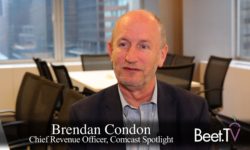US pay-TV adoption is at its lowest rate since 2007, according to Leichtman Research Group.
Fifty-nine percent of homes which get TV over antennae now also subscribe to subscription video-on-demand, according to Nielsen.
US households are nearing three SVOD subscriptions per household, according to Ampere Analysis.
Whichever numbers you look at, subscription TV over internet is eating in to the traditional pay-TV and telco bundle – and more services are still yet to come.
In to that melee, Apple in March previewed its own TV ambitions, in an underwhelming presentation that left many onlookers confused.
But one thing is for sure – the SVOD arms race may not have infinite capacity to scale.
“I think there will be so much happening that the consumer will be overwhelmed,” says Irwin Gotlieb, WPP senior advisor, in this video interview with Beet.TV.
“By the time you replace your triple play package with an internet package and a cell phone and a few content packages, you’re paying what you used to pay for the triple pay, if not more.
“There will be several that survive, but there will be substantial fallout over time. I think trying to market all these services at the same time is going to be really, really challenging because the consumer’s not going to understand or differentiate between them.”
To Netflix, Amazon, Hulu and many others, add Disney+, a new AT&T service and more yet to be unveiled to a growing list of subscription video operators.
They may be competing with traditional cable, but Gotlieb sees a historical pattern repeating itself – if SVOD services drive up their prices, as HBO did, they may stay with low subscriber numbers.
Breaking News Update: On March 31, Comscore announced that Gotlieb will join the board as part of a major management shake-up.
Beet.TV recorded this interview at the Advanced Advertising Summit in New York City.































